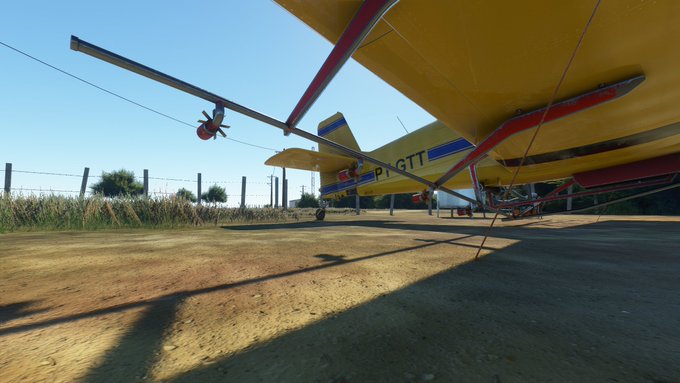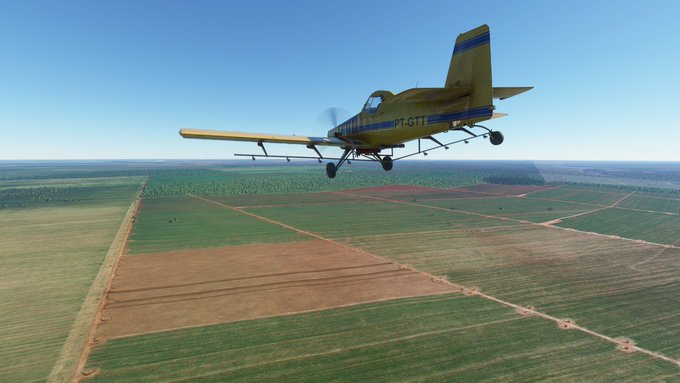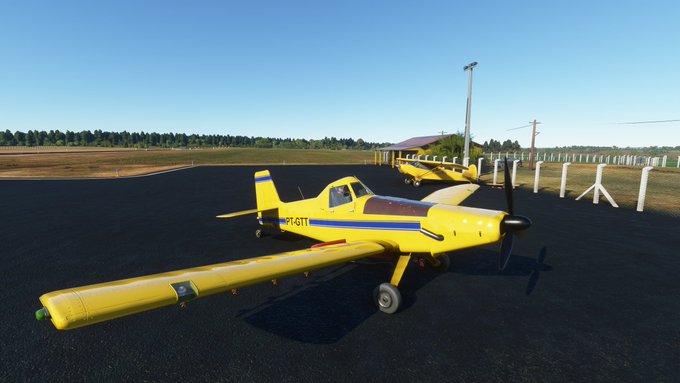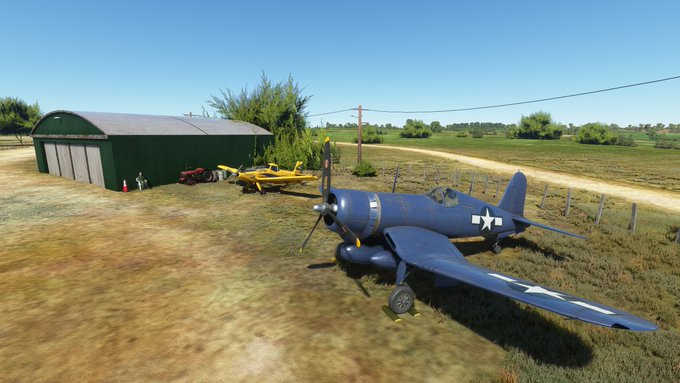December 15, 2022
Today in Microsoft Flight Sim, I’m off to the interior of Brazil to fly the Embraer EMB200 Ipanema, and explore the surprisingly fascinating world of crop dusters.

f this airplane looks familiar, that’s because it was the model for Dusty Crophopper in the movie Planes.

Well, technically Dusty is an Air Tractor AT-502, manufactured in Texas not Brazil, but the EMB200 is a virtually identical airplane.

The small airstrip I’m at is Fazenda Poruina (SJHH) in the western part of Goias Province. It’s basically a farm, in a area well known for growing soybeans.

So first let’s just look at the cockpit. It’s a one-seater, controlled by a center stick. There’s a prominent GPS in the center of the panel, whose purpose I’ll explain once we’re airborne.

The throttle and mixture controls are on the left, so you fly with your right. This particular Brazilian model has a fixed propeller, but some of these same planes in the US have not only a constant speed propeller, but also a turboprop engine.

In our case, our EMB200 has a 6-cylinder 260hp piston engine.

Behind the engine, and directly in front of the cockpit, covered by a brown hatch, is the hopper – the container for the (normally liquid) chemical to be sprayed on the crops.

And you can see that we are loading the chemicals onto the plane right now by hose, before takeoff.

The “dry” loading valve, designed to protect against leakage, conducts the chemicals to the hopper.

When we’re airborne and it’s time to spray the chemicals onto the fields, this fan – turned by the airstream – generates the pressure to pump them out of the hopper.

The chemical is pumped through pipes out along the booms under the wings, where it is release from these valves.

You’ll see, it’s going to be pretty cool. The hopper is loaded, I’ve started the engine, and I’m now making the world’s shortest taxi …

About five feet to the start of the runway, which is a dirt path about as wide as the airplane itself, bordered with barbed wire fence on either side. At least I have a headwind.

I am keenly aware this is a tailwheel that is going to want to veer off center the moment the tail lifts, and I don’t have a lot of room to veer anywhere without taking out some pickets.

But a few sharp kicks of the rudder and I somehow stayed centered, and got off the ground.

The province of Goiás lies west of the inland capital of Brasilia, which was constructed in 1960. I actually rented a car from Brasilia a few years ago and drove out into a countryside just like this.

Passing back over the dirt airfield and the small farm next to it.

So I’m looking around wondering where all the soybeans are that I’m supposed to spray, because this looks like the scrub brush terrain I remember, pocked with red clay termite mounds.

It takes a little while, flying west towards the border with Matto Grosso dul Sul province, but I’ve found plenty of soybeans ahead.

Ok, I’m going to be upfront right now and tell you this is NOT how you dust crops. In the real world, you fly about 2 feet off the ground, at 150mph, with your wheels almost touching.

But there is absolutely no way I can do that in MSFS, jump out of the cockpit to take an external screenshot, and hop back in without crashing the plane. So this is just to demonstrate what the crop-spraying effect looks like.

This is what it looks like in real life. It’s impressive, and worth a watch.
All the time they’re using the GPS screen to fly a programmed pattern, like a tractor or a harvester, up one row, turn, then down the next, like painting with a brush to spray the whole field.

You might be surprised to learn that there are around 2,700 licensed crop dusting (“agricultural aviation”) pilots in the US. I don’t have figures for Brazil, but with all their soybeans, I bet it can’t be far off.

Why use planes? After heavy rains, fields aren’t always accessible to ground machinery. Also, it’s quicker, especially for crops like soybeans that require a lot of otherwise time-consuming chemical treatments to stay healthy and maximize yields.

Because crop dusters must operate so close to the ground, pilots require a special license that allows them to ignore the normal minimum altitude rules (1,000 feet in congested areas, 500 feet outside).

A crop dusting pilot in the US will typically work four months of year (summer) every day from day till dusk, getting paid by the acre. In that period, they might earn $60-80,000, and have the rest of the year to rest or hold another job.

In just the past few years, Brazil has surpassed the US in soybean production, mainly centered in this central inland region of Goiás and Mato Grosso.

A growing portion of Brazil’s crop is exported, particularly to China.

Since the 1970s, large swathes of what were once forests have been cut down in inland Brazil to grow soybeans. It’s both a vital economic resource and a subject of great controversy.

To conserve resources – and save money – the EMB200 was designed to run completely on ethanol as fuel.

Here’s a good video summary of the global forces driving soybean production in Brazil, and its implications:
As I pass westward over the border with Mato Grosso do Sul, there’s soybeans as far as the eye can see – and a little more spraying to do (why not?)

I’m approaching the town of Costa Rica, which has a paved airport ahead for me to land.

On left downwind to land at Costa Rica.

The approach speeds are very similar to a Cessna 172, but I’m fighting a stiff crosswind from the left.

Landing any tailwheeler in a crosswind is tricky. I didn’t ground loop, but in the process of kicking the rudder to avoid ground looping, I ended up in the grass.

Taxiing up to refuel.

Hope you enjoyed a little glimpse of Brazil, as well as the world of crop dusting.

I couldn’t resist this at the end. Look, it’s Dusty and Skipper.

An interesting video on whether drones will replace manned crop dusters:
Leave a Reply